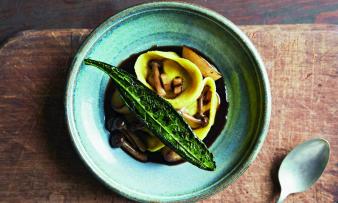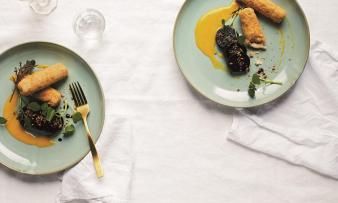Table of contents
Red table wine is an alcoholic beverage made from the fermented grapes of the noble grape vine ( Vitis vinifera ) .
Use in the kitchen
In the kitchen, red wine is often used in braised dishes, stews and marinades. Cooking in red wine intensifies the colour of the dish, which is why it is often used for apple and red cabbage or red wine and pears. Thanks to its ability to give dishes a light pink to red colour, it is also sometimes used for sweet dishes and desserts, such as red wine cake with chocolate or red wine cream. Red wine is also popular for refining gravy or it can be used to make a red wine and plum sauce . It is also possible to caramelise onions and carrots in red wine together with a little sugar .
Red wine is popular as an alcoholic drink on its own or it can be used to make mulled wine. To make this, you take red wine and heat it together with sugar , orange , cinnamon stick , cloves , star anise and cardamom .
Vegan recipe for pink red wine risotto
Ingredients (for 4 people): 600 ml red wine, 2 onions , 1 tbsp rapeseed oil , 400 g short grain rice (risotto rice) , 1.5 l vegan vegetable stock , 3 tbsp yeast flakes , 2 tbsp chopped basil ,black pepper , salt .
Preparation: Reduce the red wine in a small pan until it is about half the volume. Peel the onions and chop finely. Put the rapeseed oil in a second pan, heat it and sauté the onions until translucent. Add the risotto rice and sauté gently until it is translucent. Deglaze with the thickened red wine. Gradually add the vegetable stock in small portions. Stir continuously until the liquid has evaporated before adding more vegetable stock. Cook on a medium heat for about 30 minutes until the rice is creamy but still slightly firm. Remove the pan from the heat, stir in the chopped basil and yeast flakes. Season with salt and pepper and serve immediately.
Vegan recipes with red table wine can be found under the note: " Recipes that have the most of this ingredient ".
| Not only vegans or vegetarians should read this: Vegans often eat unhealthily. Avoidable nutritional mistakes . |
Purchasing - Storage
Red table wine can be bought from major retailers such as Coop , Denner , Volg , Spar , Aldi , Lidl , Rewe , Edeka , Hofer and Billa , some of which are organic. Migros sells red wine via its online shop. Organic wines can also be found in Denn's Biomarkt and Alnatura . Table wine is available all year round .
The availability of red table wine varies depending on the size of the store, catchment area, etc. If you are interested, click on our recorded food prices for the DA-CH countries (above under the ingredient image). There you will find current prices from various supermarkets and their price development.
Conventionally produced wine is often sulphurized several times. This is indicated on the label with "contains sulphites ". "Unsulphurized" wines can sometimes be found in organic supermarkets and specialist wine shops. There are also increasingly low-alcohol or alcohol-free wines on the market that do not differ in taste from regular wines. So-called "natural wines" are also becoming increasingly popular. These are produced without the addition of pure yeast (wine yeast), but through "natural" spontaneous fermentation. The wines are not sulphurized and are not refined or clarified.
What is vegan wine? In conventional wine production, animal products (egg white or gelatin) are usually used to filter out cloudy substances (fining). Vegan wine , on the other hand, is filtered with mineral earth (betontite). 8
Storage tips
Table wine should be drunk within a year and is therefore not intended for long-term storage. It can be kept at room temperature or in the cellar. It is important to keep it at a constant temperature and to protect it from light and heat. If possible, it should be stored lying down. Opened table wine will keep in the fridge for around a week. With a wine vacuum pump and a suitable stopper, the oxygen can be extracted from the bottle and the shelf life can be extended by a few days.
Ingredients - Nutritional values - Calories
100 g of red table wine has an energy content of 85 kcal. Red wine is fat-free and almost protein-free at 0.07 g/100g. The carbohydrate content is low at 2.6 g/100g. 1 It has an average alcohol content of 12-14.5% by volume. 2 It also contains small amounts of manganese and potassium , as well as other nutrients. 1
In comparison, white table wine contains fewer calories (82 kcal/100g) and less alcohol with 11.5-14% vol. 2
The complete ingredients of red table wine, the coverage of the daily requirement and comparison values with other ingredients can be found in our nutrient tables. In the article Nutrients explained you will get a detailed insight into the topic.
Effects on health
The effects of wine consumption on health have been the subject of a long-standing debate.
Wine contains many bioactive substances, including flavonoids and polyphenols such as resveratrol. 13 Studies show that resveratrol has antioxidant, anti-inflammatory and anti-carcinogenic properties that may be relevant for the prevention or control of chronic diseases in humans. 13,18 Since 2016, a synthetic variant of resveratrol has been approved as a dietary supplement. 20 As with most phytochemicals, including resveratrol, it is important to define its absorption and metabolism rate in order to clearly define its potential health effects. The absorption rate is around 75%, but the bioavailability is poor. This means that the human body cannot utilize resveratrol well. 19 These bioactive substances are also present in red grape juice . Numerous studies show that grape juice has a similar antioxidant effect to red wine. 14
Several epidemiological studies show that people with low to moderate consumption of alcoholic beverages have a lower risk of cardiovascular disease and a reduction in overall mortality (death rate) than people who do not consume alcoholic beverages or who consume them in large quantities. 13,23 The effect was observed with the consumption of (red) wine, beer and spirits. Therefore, the effect could also be due to the alcohol and not to the bioactive substances contained in them. 23,24
Clinical studies on the effects of alcoholic beverages and various foods showed that positive effects on the health parameters examined were primarily found in the combination of red wine and a dish based on the "Mediterranean diet." The effect was less pronounced with white wine and vodka and also in combination with fatty foods. 15,16 The composition of the dish therefore seems to be just as important or even more important for the positive health effect than the type of alcoholic beverage. In addition to moderate consumption, "drinking habits" could also have an influence. This is because the body metabolizes alcohol more slowly when eating at the same time. 13
In the debate about healthy "red wine consumption", reference is often made to the "French Paradox". An epidemiological study from the 1980s concluded that fewer people in France died of cardiovascular disease than in other countries, despite consuming high amounts of saturated fat, which increases the risk of cardiovascular disease. This led to the hypothesis that high red wine consumption must reduce the risk. 21 Since the consumption of saturated fat in France rose to the same level much later than in Great Britain, for example, this is more likely to be a delay and the risk of dying from cardiovascular disease is also increasing in France. 22
Finally, the potentially health-promoting effects of moderate red wine consumption should not be overestimated, as long-term consumption of alcoholic beverages in large quantities leads to long-term and sometimes life-threatening negative consequences.
Dangers - Intolerances - Side effects
Red table wine contains alcohol. Humans have a mechanism for breaking down alcohol (ethanol). However, this is geared towards minimal amounts and not the ethanol content that is common in alcoholic beverages. The main place where ethanol is broken down is the liver. There, certain enzymes (alcohol dehydrogenase ADH) oxidize the ethanol to toxic acetaldehyde. This is considered carcinogenic. The body oxidizes acetaldehyde to acetate and excretes it in urine, sweat and breath. 5 Acetaldehyde is also contained in wine due to alcohol fermentation. 6 Long-term and high alcohol consumption can lead to liver damage (fatty liver and cirrhosis). Other possible consequences are reflux (heartburn), high blood pressure, obesity, damage to the nervous system and an increased risk of cancer. 5
Wine contains large amounts of histamine and the alcohol it contains is a histamine liberator, meaning that alcohol promotes the release of histamine stored in the body. People with histamine intolerance should therefore limit or avoid alcohol consumption. 7
Ecological footprint - animal welfare
The ecological CO 2 footprint of wine depends, among other things, on grape production and processing, transport routes and packaging. In a 2020 study for products in Germany, an amount of 1.0 kg CO 2 eq was calculated for 0.75 liters of wine in a disposable glass bottle, which means 1.33 kg CO 2 eq are produced per kg of wine. 25 The largest contribution to the resulting emissions comes from both wine growing and the use of glass bottles as packaging material. 26
The amount of water needed to produce 1 kg of wine is 869 litres, slightly more than for the production of grape juice (675 litres). 27 A large part of this water is used to grow the grapes. This is a particularly big problem in countries that are already struggling with water shortages due to climatic conditions and have to resort to artificial irrigation to irrigate the grapes (for example Italy). 28 With the future prospect of rising temperatures and increased droughts as a result of climate change, wine growing in Central Europe is facing a challenge. 29
In organic viticulture, where synthetic pesticides and herbicides are not allowed to be used, dealing with mildew and other fungal diseases is a major problem. Often, copper-containing pesticides are used instead, but due to their ecotoxicological properties, these have a negative impact on the environment, just like the herbicides used in conventional agriculture. 30 Intensive research is currently being carried out to find effective alternatives.
In order to promote biodiversity in viticulture, one can, for example, refrain from mowing and mulching the vineyard rows and sow wild flowers, as is already practiced by some winegrowers. 31
As temperatures rise worldwide, the sugar content in grapes and therefore the alcohol content in wine increases. At the same time, the acid content decreases, which affects the taste composition of the wine. Wine therefore increasingly has to be dealcoholized and treated with tartaric acid in order to meet the taste of consumers. 11,12 In addition to dealcoholization, attempts are being made to reduce the alcohol content by adding water to the mash/must during production or by using new strains of yeast that produce less alcohol. 17
Worldwide occurrence - cultivation
The oldest evidence of wine production comes from Egypt and Assyria and dates back to 3500 BC. The grapevine Vitis vinifera ssp. vinifera originally comes from the Near East. Grapevines have been cultivated in Greece since 1500 BC and today throughout the Mediterranean and Central Europe. Knowledge of wine production spread along with the cultivation of grapevines. 3
According to FAOSTAT , 26.7 million tons of wine were produced worldwide in 2020. The main producers were Italy (5.1 million tons), France (4.4 million tons) and Spain (4.1 million tons). 9
Cultivation - Harvest
Wine is mainly made from the berries of the noble grapevine ( Vitis vinifera ), less often from muscadine grapes ( Vitis rotundifolia ). Information on the cultivation of grapes can be found under the linked ingredients.
Harvesting and vintage were traditionally done by hand and in Europe between September and November. After harvesting, the grapes are sorted and the stalks and vines are separated from the grapes. Nowadays, this is sometimes done mechanically using a vibrating and shaking technique. 3
Industrial production
The red coloring (anthocyanins) in red wine comes from the skins of red-blue grapes. This is why, in contrast to white wine, red wine is produced by fermenting the mash (which still contains the skins) instead of the must (juice without solid components).
After the harvest, vintage and destemming, the grapes are crushed by squeezing (mashing). The grape seeds must not be damaged, otherwise tannins will be released, which will make the wine bitter. An initial sulphurization stops any spontaneous fermentation. In order to extract as much aroma and color as possible from the grape skins, enzymes are sometimes used or the mash is cooled and left to rest for a while.
The addition of pure yeast (wine yeast) triggers the mash fermentation. The yeast converts the sugar contained in the wine into alcohol and carbon dioxide. Fermentation continues until the sugar contained in the wine is converted or the alcohol content rises so high that the yeast dies. The mash is then separated into juice (must) and solid components (pomace). This process is called pressing. The young wine is then sulphurised to stabilise it and kill the yeast.
The so-called wine aging process takes place, in which the wine is transferred to barrels (racking) and sulphurized again, and if necessary deacidified and blended (mixing different wines). After clarification and fining (filtration of the sediment), the wine is filled into barrels (quality wine) or bottles (table wine) for maturation and storage. 3.10
An alternative method of producing red wine involves heating the mash to 60 to 80 °C, which dissolves the aromas and colorings. The mash is then separated into juice (must) and solids (pomace) before the yeast is added for fermentation. The method of production is therefore similar to that for white wine, which also involves must fermentation. Heating the mash and subsequent must fermentation is easier to control than the usual mash fermentation. However, it changes the aroma structure of the wine, which is why it is not without controversy. 10
Further information
Red wine is made from berries of the noble grapevine ( Vitis vinifera subsp. vinifera ). This belongs to the genus of grapevines ( Vitis ), which is part of the grapevine family ( Vitaceae ). The individual fruits of the fruit cluster are called grapes, colloquially often called wine grapes.
Table wine, also known as drinking wine, is a young wine that cannot usually be stored and is intended for rapid consumption (within a year). It is a wine without an indication of origin or year and is not subject to any special quality testing. It therefore belongs to the lowest quality level of wine. In contrast, quality wine or Prädikatswein are officially tested wines in which the selection of grape varieties is more limited and the specifications regarding the production process are stricter.
Grapes can be eaten raw (table grapes), dried into raisins or processed into grape juice , wine and brandy. Spirits such as grappa are made from pomace, the residue left over from wine production. Grape seed oil is obtained from the seeds of grapes.
Alternative names
Table wine is also known as drinking wine and country wine. Other names are everyday wine, consumption wine, draft wine, pint wine, table wine, tap wine or drinking wine. The English name is table wine or dinner wine.










Comments